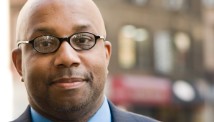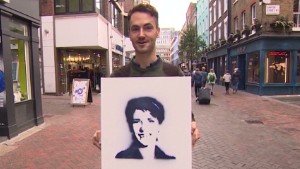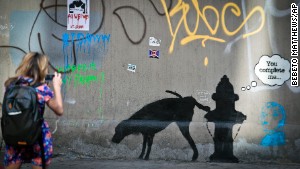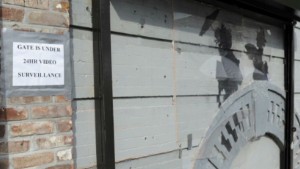Editor's note: Errol Louis is the host of "Inside City Hall," a nightly political show on NY1, a New York City all-news channel.
(CNN) -- The secretive British artist Banksy, not content with the immense publicity already generated by his recent decision to create graffiti and other art installations around New York City each day for a month, may have finally worn out his welcome.
In a crude, obscene bid for attention, Banksy published a rant on Sunday against One World Trade Center, calling it a "shy skyscraper" that "so clearly proclaims the terrorists have won."
"You currently have under construction a one thousand foot tall sign that reads, 'New York -- we lost our nerve,'" he wrote. "One World Trade Center declares the glory days of New York are gone."
 Errol Louis
Errol Louis New Yorkers, who are still recovering from the billions of dollars and thousands of lives lost at the World Trade Center on September 11, 2001, reacted with understandable outrage.
"TOWERING INSULT" screamed the front-page headline of the New York Daily News, proclaiming that Banksy "spits on graves of 9/11 victims."
New York is a city long accustomed to attention-seeking huckster-artists who push -- and exceed -- the limits of decency and good taste. But even in a town that gave the world Warhol, Madonna, Diddy and Lady Gaga, the Banksy screed against the World Trade Center site was a bit much to bear.
Banksy, who perhaps imagines he's bringing a fresh, avant-garde perspective to the issue, is actually joining the conversation about a decade too late. Back when the World Trade Center was still a smoking, twisted pile of debris, all sorts of New Yorkers -- from planners and artists to financiers, politicians and everyday citizens -- had begun a vast, anguished debate over what, if anything, should be built on the 16 acres where so many perished.
Countless planning meetings were held, involving arts groups, real estate professionals, engineers and political leaders. A string of group brainstorming sessions (called charrettes) was convened, where different ideas were sketched out and turned into models. Artists and architects were invited to dream up something new, and nine different designs emerged.
 Making a DIY 'Banksy'
Making a DIY 'Banksy'  Banksy brings art to the masses
Banksy brings art to the masses  Owners protect 'Banksy'd' building
Owners protect 'Banksy'd' building I was one of the planners behind an extraordinary two-day public planning session, called Listening to the City, in which thousands of New Yorkers gathered at a convention center and spent hours discussing and electronically voting on the different visions, and talking about the principles that should govern the rebuilding.
Groups of total strangers sat and asked one another key questions. How much space should be devoted to commerce? How large should the memorial be? Should the site be returned to its original use as an office tower, or turned into a Gettysburg-type urban meadow (the use suggested by ex-Mayor Rudy Giuliani)?
At the time, there was a serious question about whether any large companies would choose to relocate in a place that had twice been attacked by terrorists. And along the way, we tackled the very issue Banksy is now whining about: What effect will the new building have on the city skyline?
New Yorkers also debated whether to create a memorial near, beneath or alongside a new building. In the end, we opened the memorial design to the entire world, resulting in more than 5,000 entries, constituting the largest design competition in history. One wonders if Banksy bothered to send in a sketch.
The matter was largely resolved the way big public questions are supposed to get settled in a democracy: through a chain of public and private conflicts and compromises that generated a final product reflecting many visions.
Like many iconic buildings in New York, One World Trade Center is a place of commerce, continuing a tradition that created the New York skyline -- from the Woolworth Building (the first skyscraper) to the Chrysler Building, Citicorp Center and the original World Trade Center itself.
The men who designed and built these and many other bold cathedrals of capitalism were trying to make money, not art. Larry Silverstein, the developer of the World Trade Center, received a multi-billion-dollar insurance payment for the destroyed building, under terms that included a requirement that he rebuild and lease an equivalent amount of commercial space.
And after the loss of 3,000 people in one of the worst atrocities ever committed on American soil, the issue of security was seared into the thinking of the public and private authorities involved in rebuilding the site.
New Yorkers fought, fussed and financed for years. "104 floors of compromise?" asks Banksy. Well, yes. The basic proposition of America -- the Latin motto printed on our currency -- is "e pluribus unum": out of many, one. The new building, and the process that led to its creation, is quintessentially American, right to the peak of its spire, specifically designed to soar exactly 1,776 feet in the air, a nod to the year we broke from British domination in the founding act of American audacity.
Banksy, a British citizen, seems to have missed or misunderstood the symbolism, and much else, in his short time in New York. Needless to say, the democratically generated blend of culture and commerce at the World Trade Center site -- which draws millions of visitors, dwarfing any audience Banksy is likely to have -- will stand as a monument to our values and drive long after sarcastic visiting artists have moved on.
Follow us on Twitter @CNNOpinion.
Join us on Facebook/CNNOpinion.
{ 0 comments... read them below or add one }
Post a Comment